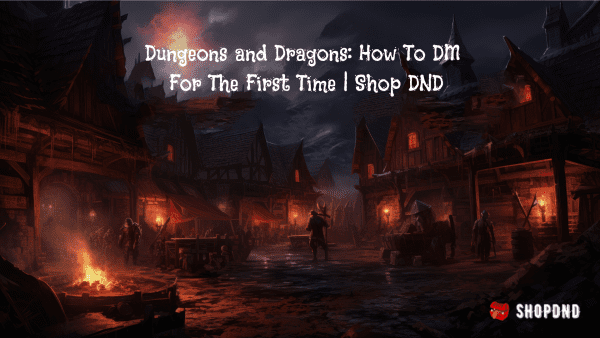
Dungeons and Dragons: Guide on How To DM For The First Time
Welcome to Shop DND’s comprehensive guide on how to DM for the first time in Dungeons and Dragons. Whether you're a seasoned player taking the reins for the first time or a complete newcomer to the world of tabletop RPGs, Our guide will provide you with everything you need to know to confidently step into the role of Dungeon Master (DM). Let's delve into the intricacies of Dungeon Mastering and learn how to create unforgettable adventures for your players.
Dungeons and Dragons: Guide on How To DM For The First Time
What is Dungeon Mastering?
Dungeon Mastering, often abbreviated as DMing, is the art of guiding players through an interactive storytelling experience within the Dungeons and Dragons universe. As a DM, you'll act as the narrator, referee, and creator of the world in which your players' adventures unfold.
Dungeons and Dragons: Guide on How To DM For The First Time
Understanding the Role of a Dungeon Master
Responsibilities of a Dungeon Master
As a Dungeon Master, you hold several crucial responsibilities. You are the architect of the game world, responsible for creating and narrating its environments, characters, and challenges. Additionally, you enforce the rules of the game, ensuring fair play and maintaining a sense of balance and challenge throughout the adventure.
Role in Storytelling and World-Building
Your primary role as a Dungeon Master is to craft compelling narratives and build immersive worlds for your players to explore. Through descriptive storytelling and engaging characters, you'll bring the game world to life, captivating your players and drawing them into the adventure.
Dungeons and Dragons: Guide on How To DM For The First Time
Preparing to DM for the First Time
Familiarising Yourself with the Rulebooks
Before you begin your journey as a Dungeon Master, it's essential to familiarise yourself with the core rulebooks of Dungeons and Dragons. The Player's Handbook, Dungeon Master's Guide, and Monster Manual are invaluable resources that provide essential rules, guidance, and inspiration for your adventures.
Choosing or Creating an Adventure
When preparing to DM for the first time, you have the option to run a pre-made adventure or create your own. Pre-made adventures, such as those found in published campaign modules, provide a ready-made framework for your game while creating your own adventure allows for greater flexibility and creativity.
Preparing Game Materials
To run a successful game, you'll need to gather and prepare various materials, including character sheets, maps, NPCs (non-player characters), and encounter plans.
- Character sheets: These documents detail the abilities, skills, and equipment of the player characters.
- Maps: Maps provide visual representations of the game world, including locations, terrain, and points of interest.
- NPCs: Non-player characters are essential for populating your world and interacting with the players.
- Encounter plans: These documents outline the challenges and obstacles that the players will face during the game, including combat encounters and roleplaying scenarios.
Dungeons and Dragons: Guide on How To DM For The First Time
Setting Up the Game Environment
Choosing a Suitable Location
Selecting the right location for your game is crucial for creating a comfortable and immersive atmosphere. Whether you're playing at home or in a public space, ensure that the environment is quiet, well-lit, and conducive to focused gameplay.
Creating Ambience
To enhance the immersion of your game, consider adding background music and visual aids to set the mood. Atmospheric music can help establish the tone of the adventure, while visual aids such as maps, miniatures, and props can bring the game world to life.
Organising the Playing Area
Before the session begins, take the time to organise your playing area for maximum efficiency. Ensure that all necessary materials are readily accessible and that players have ample space to roll dice, consult character sheets, and engage with the game.
Dungeons and Dragons: Guide on How To DM For The First Time
Starting the Session
Introducing Players to the World
At the beginning of the session, take a few moments to introduce your players to the world in which their adventure takes place. Provide them with a brief overview of the setting, including any relevant lore, history, or current events.
Setting the Scene
Once the players are familiar with the world, set the scene for the adventure by describing their immediate surroundings. Use vivid language to paint a picture of the environment, engaging the players' senses and drawing them into the narrative.
Clarifying House Rules
Before diving into the game, clarify any house rules or modifications to the standard ruleset that you'll be using. This ensures that all players are on the same page and prevents misunderstandings or confusion during gameplay.
Dungeons and Dragons: Guide on How To DM For The First Time
Managing Gameplay
Facilitating Player Actions
As the game progresses, your role as a DM is to facilitate the actions of the players. This involves describing the outcomes of their actions, interpreting the rules, and resolving any challenges or obstacles they encounter.
Resolving Conflicts and Challenges
Conflicts and challenges are an integral part of any Dungeons and Dragons adventure. When conflicts arise, use the game's rules and mechanics to determine the outcome, ensuring that the resolution is fair and consistent.
Adapting to Player Choices
One of the most exciting aspects of Dungeon Mastering is adapting to the choices and actions of your players. Be prepared to improvise and think on your feet as the players explore the game world and make decisions that shape the course of the adventure.
Dungeons and Dragons: Guide on How To DM For The First Time
Running Combat Encounters
Understanding Combat Mechanics
Combat encounters in Dungeons and Dragons follow a set of rules and mechanics designed to simulate the chaos of battle. Familiarise yourself with these mechanics, including rules for attacks, damage, and movement.
Initiative and Turn Order
At the beginning of a combat encounter, determine the initiative order to establish the sequence in which characters take their turns. This ensures that combat flows smoothly and fairly, with each player and enemy getting a chance to act.
Using Monsters and NPCs
When designing combat encounters, consider the abilities and tactics of the monsters and NPCs involved. Tailor the encounters to the strength and capabilities of the player characters, providing a challenge without overwhelming them.
Keeping Combat Engaging and Dynamic
Combat encounters should be engaging and dynamic, with plenty of opportunities for player strategy and decision-making. Use terrain features, environmental hazards, and interactive elements to create dynamic and memorable battles.
Dungeons and Dragons: Guide on How To DM For The First Time
Handling Roleplaying Encounters
Developing Non-Player Characters
Non-player characters (NPCs) are essential for bringing the game world to life and providing opportunities for roleplaying. Develop memorable NPCs with distinct personalities, motivations, and quirks to enrich the players' interactions.
Encouraging Player Roleplay
Encourage your players to engage in roleplaying by immersing themselves in their characters and interacting with NPCs and each other. Provide opportunities for dialogue, negotiation, and character development throughout the adventure.
Managing Dialogue and Interaction
As the DM, you'll portray the various NPCs that the players encounter and facilitate their interactions. Use different voices, mannerisms, and speech patterns to distinguish between characters and enhance the roleplaying experience.
Dungeons and Dragons: Guide on How To DM For The First Time
Dealing with Unexpected Situations
Improvisation Techniques
No matter how well you prepare, unexpected situations are bound to arise during gameplay. Develop improvisation techniques to adapt to these situations on the fly, maintaining the flow of the game while keeping it engaging and exciting.
Handling Rule Disputes
Inevitably, disputes over rules or interpretations may arise during the game. When this happens, use your knowledge of the rules and the spirit of fair play to resolve the dispute quickly and decisively, keeping the game moving forward.
Maintaining Game Balance
Maintaining game balance is essential for ensuring that all players have an enjoyable and rewarding experience. Be mindful of the difficulty of encounters, the distribution of rewards, and the progression of the story, balancing challenge with fairness.
Dungeons and Dragons: Guide on How To DM For The First Time
Managing Player Progression
Awarding Experience Points
As the players overcome challenges and complete objectives, award them experience points (XP) to reflect their accomplishments. XP is used to track player progression and determine when characters level up and gain new abilities.
Balancing Rewards and Challenges
When designing adventures, strike a balance between the challenges presented to the players and the rewards they receive for overcoming them. Ensure that the difficulty of encounters is commensurate with the rewards offered, keeping the game challenging yet fair.
Advancing the Storyline
Advance the storyline of your campaign over multiple sessions, introducing new plot threads, challenges, and revelations to keep the players engaged and invested in the narrative. Pay attention to the choices and actions of the players, incorporating them into the ongoing story.
Dungeons and Dragons: Guide on How To DM For The First Time
Concluding the Session
Wrapping Up Loose Ends
As the session draws to a close, take the time to tie up any loose ends and resolve any remaining storylines or plot threads. Provide closure for the players, ensuring that they feel a sense of accomplishment and completion.
Soliciting Feedback
After the session, solicit feedback from your players to gauge their enjoyment of the game and identify areas for improvement. Listen to their comments and suggestions, using them to refine your skills as a Dungeon Master and enhance future sessions.
Preparing for the Next Session
Finally, begin preparations for the next session by reviewing your notes, updating your campaign materials, and planning new adventures and encounters. With each session, you'll grow more confident and skilled as a Dungeon Master, providing your players with unforgettable gaming experiences.
Dungeons and Dragons: Guide on How To DM For The First Time
Conclusion
Remember, the key to success as a Dungeon Master is preparation, adaptability, and creativity. With dedication and practise, you'll become a master storyteller and guide, leading your players on epic adventures through the realms of Dungeons and Dragons. How to DM for the first time, you ask? Follow our guide, and let your imagination soar!
Suppose you are looking for customised DND apparels like, t shirts, hoodies, and vests to further express your passion for the game, Visit Shop DND, your home to custom dungeons and dragons merchandise. You may also visit our social media profiles like Facebook, TikTok, and Instagram to stay updated on the latest news, promotions, and exclusive offers from ShopDnD.


